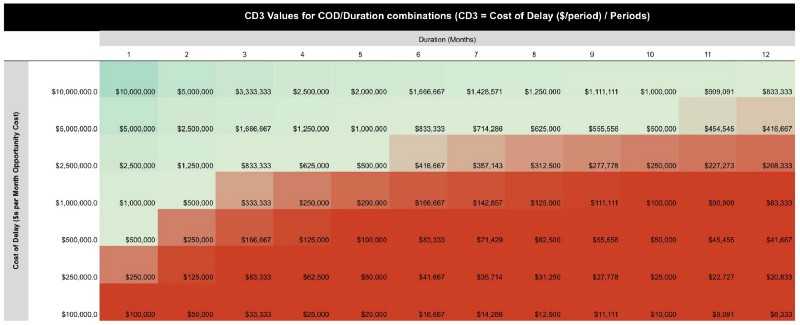Consider this table. The columns represents mission duration (in months). The rows are Cost of Delay ($s per month opportunity cost). The cells are CD3…the Cost of Delay divided by the expected number of periods until completion.
CD3: Cost of Delay Divided by Duration is a prioritisation/scheduling method that maximizes the value delivered in a given time period when you have limited capacity. It is particularly useful in environments where a primary constraint of the system is the available time of a relatively fixed or “scarce” resource. This matches product development very well, because of the communication, collaboration and coordination overheads, which constrain our ability to increase capacity.

Thinking in terms of CD3 can help tease out opportunities for better prioritization.
Let’s say that twelve months is the MAXIMUM duration for the $10,000,000 per month opportunity (first row), but we’re not sure whether it will take one month, four months, eight months, or twelve months (the max). Or maybe, hopefully, that we see opportunities to deliver incremental value against the $10,000,000 per month effort. Well…chances are we should work on this effort as few other options (especially below $5,000,000 per month CoD) are more attractive.
Lesson #1: For the “most valuable stuff”, duration probably doesn’t matter as much as you think. Your focus should be on trying to incrementally exploit the opportunity. Don’t waste time prematurely converging on a design/plan for the purpose of providing a more accurate estimate. Experiment quickly to “prove out” that estimate of High Value.
On the flip side, if something can predictability take one month to complete and looks reasonably valuable (maybe $750,000+ CoD)…well, we should probably heavily consider that option.
Lesson #2: “Small stuff” with tighter confidence around duration can be very competitive in terms of prioritization. Whenever possible, bite off undeniably small slices of work. This is the work that jumps out as “low-hanging fruit”…we are confident about the value and the scope/duration.
Combining Lesson #1 and Lesson #2, we get…
Lesson #3: The perfect storm is “the most valuable stuff” with a high confidence of being able to deliver value incrementally. The big honking $10,00,000 12-monther becomes 12x$1,000,0000 1-monthers. One month efforts buy us flexibility and don’t lock us in. Now we’re talking…
OK. You’re probably saying “no shit, this is so basic it’s painful!” But you would be amazed how many teams routinely either
- spend time on red-like low value opportunities (see the table)
- miss opportunities to incrementally deliver value with smaller batches
- spend an inordinate amount of time pre-planning, pre-converging on solutions for their most valuable opportunities
- provide no autonomy for teams to tackle the low-hanging fruit
- worry too much about tighter estimation ranges for medium/large batches Now…I bet you’re saying:
But if we COULD know durations perfectly, then we could optimize even further! We could sequence the work better. So why not try?Lesson #4: Correct (in theory). But not just for durations…you’d need to do the same thing for value as well. And at a certain point you’d need to step back and see if that extra work estimating and planning was creating extra value, or whether it was negatively impacting decision quality and design/solution quality (which happens frequently).
At least in my experience with rapidly growing companies, you are typically dealing with some undeniably valuable opportunities and some undeniably small interventions of medium/high value. Focus there. Get good at delivering value continuously/incrementally. And then worry about eking out the remaining value opportunities from the system with “better planning”.